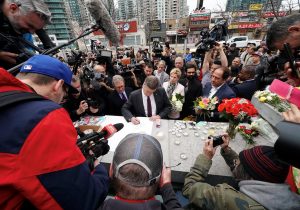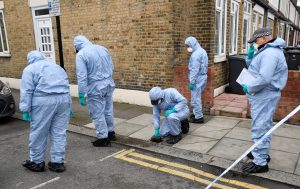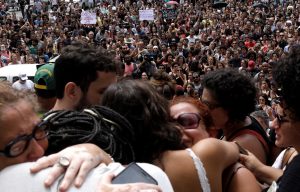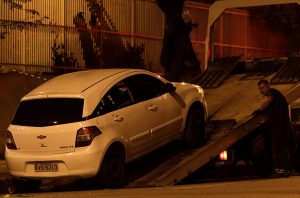
By Fayaz Bukhari
SRINAGAR, India (Reuters) – Eight men accused of involvement in the rape and murder of an eight-year-old Muslim girl in India’s Jammu and Kashmir state appeared in court on Monday for the first hearing in a case that sparked nationwide outrage and criticism of the ruling party.
The girl, from a nomadic community that roams the forests of Kashmir, was drugged, held captive in a temple and sexually assaulted for a week before being strangled and battered to death with a stone in January, police said.
Public anger at the crime led to protests in cities across India over the past few days, with outrage fueled by support for the accused initially shown by state government ministers from Prime Minister Narendra Modi’s Bharatiya Janata Party (BJP).
The protests have also focused on another rape allegedly involving a BJP lawmaker in the crime-ridden, most populous, poor northern state of Uttar Pradesh.
The outrage has drawn parallels with massive protests that followed the gang rape and murder of a woman on a Delhi bus in 2012, which forced the then Congress-led government to enact tough new rape laws including the death penalty.
Yet India has long been plagued by violence against women and children – reported rapes climbed 60 percent from 2012 to 40,000 in 2016, and many more go unreported, especially in rural areas.
Reports of torture, rape and murder of another child have emerged from Modi’s western home state of Gujarat.
In that case, the corpse of a girl was found near a cricket ground in the city of Surat a week ago.
The post-mortem showed she had been tortured and sexually assaulted before being strangled. The body had 86 injury marks, including some inflicted to her genitalia with hard, blunt objects, while more minor injuries suggest she had been beaten with a stick or slapped.
Doctors estimate that the unidentified girl was about 12, police said.
As the groundswell of revulsion grew, Modi assured the country on Friday that the guilty would not be shielded, but he has been criticized for failing to speak out sooner.
Before leaving for an official visit to Europe this week, Modi received a letter from 50 former police chiefs, ambassadors and senior civil servants upbraiding the political leadership over its weak response.
“The bestiality and the barbarity involved in the rape and murder of an eight-year-old child shows the depths of depravity that we have sunk into,” the former officials said.
“In post-Independence India, this is our darkest hour and we find the response of our government, the leaders of our political parties inadequate and feeble.”
The letter went further by blaming the BJP and likeminded right-wing Hindu groups for promoting a culture of “majoritarian belligerence and aggression” in Jammu, and in the Uttar Pradesh case it blasted the party for using feudal strongmen, who behave like gangsters, to shore up its rule.
The former officials said they held no political affiliation other than to uphold the values of India’s secular constitution that guarantees equal rights to all citizens. Some of the signatories have spoken out in the past also against Modi’s Hindu nationalist party accusing it of whipping up hostility towards India’s 172 million Muslims.
THREATS AGAINST LAWYER
Fallout from the 2012 rape case led to the resignation of Congress chief minister of Delhi. This time, Congress was quick to realize the mood of the country, with party leader Rahul Gandhi leading the first major protest in the capital last week.
On Monday, Gandhi tweeted that there had been nearly 20,000 child rapes in India in 2016, and urged Modi to fast-track prosecutions “if he is serious about providing ‘justice for our daughters'”.
Though the rape and killing of the girl in Kashmir had been known about for months, the backlash erupted after the charge sheet giving gruesome details of the crime was filed last week.
It alleged that the attack was part of a plan to drive the nomads out of Kathua district in Jammu, the mostly Hindu portion of India’s only Muslim-majority state.
The alleged ringleader of the campaign, retired bureaucrat Sanji Ram, looked after a small Hindu temple where the girl had been held and assaulted. Two of the eight on trial are police officers who stand accused of being bribed to stifle the investigation.
After Monday’s initial hearing in Srinagar, the judge adjourned the case until April 28 while the Supreme Court heard a petition from the lawyer representing the victim’s family to have the trial held elsewhere due to fears for her safety.
Ahead of the trial, the lawyer said she had been threatened with rape and death for taking up the case.
“I was threatened yesterday that ‘we will not forgive you’. I am going to tell Supreme Court that I am in danger,” said the lawyer, Deepika Singh Rawat, who has fought for a proper investigation since the girl’s body was found in January.
The Supreme Court also ordered security for the victim’s family after her father said he too feared for their safety.
Two ministers from the BJP, which shares power in Jammu and Kashmir, were forced to resign after being pilloried for joining a rally in support of the accused men.
(This version of the story corrects first paragraph below sub-head to show Delhi chief minister lost election, not forced to resign)
(Additional reporting by Suchitra Mohanty in NEW DELHI; Writing by Sanjeev Miglani; Editing by Simon Cameron-Moore, Robert Birsel)














